Singin' in the brain Final
1/86
There's no tags or description
Looks like no tags are added yet.
Name | Mastery | Learn | Test | Matching | Spaced |
|---|
No study sessions yet.
87 Terms
How do Marsh and Young define play?
“activities that children initiate of their own
accord and in which they may choose to
participate with others voluntarily....
Enjoyable, intrinsically motivated, and
controlled by the players”
What does all musical play have in common, across
all ages?
1) multimodality-blend movement, singing, instruments if available or other sound-making objects. Involves hearing, seeing, kinesthetics*
2) unplanned,** and improvisational
Phases of musical play
Divided into roughly 4 age ranges
1) newborn to 3 years
2) 3 to 6 years
3) 7 to 12
4) 13 through teen years
typical settings for music play
-Day cares, nursery schools, home, playground, in the car, on school buses, etc. nearly everywhere children are with some freedom to engage in play
-Form it takes depends on many factors, including what is available (singing voice vs clapping songs vs instruments)
-Usually encouraged in preschools, which are more play-based
-By age 5 or 6, kids often transition to more formal school
Musical play is also a form of _______________, differing
depending on age
social interaction
young children and types of musical play
Young children share and exchange musical ideas, imitate each other, synchronize rhythmic movement
middle childhood and types of musical play
Mid childhood-actively pass on, create and teach musical games,
songs, and activities to friends
Campbell observed and interviewed children from ages
4 to early teens, looking at ways they used music at all
ages, for different purposes and found that music is used to:
-maintain emotional and social equilibriums
-entertain themselves
-relieve the boredom of their surroundings
-create and enjoy its sonic forms
-assist in the formation of identity (p. 465)
Musical play: infancy to 3 years old
infants participate in musical exchanges with caregivers*, older babies and toddlers start to sing pieces of songs, making up their own potpourri version
Tendency to enjoy repetition, while they “master” the experience
Musical Play: Toddlers and preschoolers
Goal is engaging in process more than final product
3 main categories of musical play (vocal, spontaneous play
with instruments, movement play)
vocal play
2 main types (influenced by social context):
A. Chant-like repetitions–usually in groups (“chants”)
B. Free-flowing singing “often on open syllable sounds”-usually solo (“plainsong”)
Often take known songs and alter with different lyrics,melodic or rhythmic changes
Often accompanied by movements, either themselves or with toys
Spontaneous play with instruments-
Might at first look “random” or purposeless, like “just making noise” (in keeping with Piaget model of exploratory but unstructured play), But actually often quite sophisticated, and structured experimenting happening
One study compared music production by 3 and 4-year olds when given chance to play freely with percussion instruments, guitar, and piano compared to teacher-led class
Free play won out in terms of complexity, range and variety
Movement play
Natural for children to respond to music with movement*
Starting at about age 3, young children enjoy twirling, bouncing, and repetition
Adult Role: Will often imitate adults modeling movement- but only if movements were similar to child’s natural tempo and movement style
**To encourage movement in children, match them
and allow for reciprocal interactions
Musical Play: School-Aged Children
Children’s musical play can be surprisingly complicated
As children get older musical play takes on more social and collaborative character
Playground play—songs, chants, handclapping, hopscotch, jump rope
Age 7 or 8, children start to shift from improvisational play into a more product-oriented mindset.
Age 10 to 11 develop novel compositions in pairs-collaborative compositions
Home play
Still abundant, often using musical or technological props
bought by parents
Eg toys, instruments, video games, computers, TV, radio, etc
More often see independent play cf. earlier year
Playground play
Many chants, clapping game
Clapping pattern is in TRIPLE while chanting is in DUPLE*
Usually 6-year-olds can dothis!
Sharon Davis: Ch 14, Children, popular music, and identity
Musical engagement begins early through shared social interactions with parents
Shared early musical experiences help shape a child’s identity
*Helps child “understand and interpret their capacity for
exchange”
Early caregiver interactions helps infants begin to establish social identity
Many other factors for identity formation: eg social and cultural influences
children become enculturated into popular music styles through ”[TV], radio, movies, music videos, and games, and through personal music devices and social media”
Music listening provides “common space for bonding and communication” within the family
Popular music is everywhere!→influences on musical identities
Transition from parent orientation toward peer orientation” p. 270
Children learn music through listening, composing /improvising, practicing,
immersion.
One difference from adults is that when children make a ”mistake” they tend to start all over again*
2 forms of musical identity are:
identities in music–how are musicians categorized (eg performer or composer)–only applies to some people–identity as a musician
Music in identities-how does music fit into and shape your identity-your musical identity
Adolescence–section of Davis reading
More likely to play clapping games with siblings at home than publicly with friends, but in some cultures still encouraged and prominent–often older kids teaching the younger ones (with natural tendency to scaffold)*
Also dance routines, cheers, chants after school
Can learn and pass along very rhythmically complicated songs
Eg: Cup Song, popularized in Pitch Perfect
Siblings influence musical interactions in the home
Role of music in adolescence
Music serves as one vehicle for identity formation
Music may be a means of self-expression
Music may be used as a coping skill
Musicians/music address mental health
Preference vs Taste
Preference: Liking one piece more than another at any given point in time
Taste: overall pattern of an individual’s preference over time
3 Components of musical experience
music-Structure, style, complexity, etc
person-Age, gender, culture, occupation etc
situation- Environment, work/leisure, solo vs social
4 approaches to studying musical preferences in childhood and adolescence are:
Experimental aesthetics
Developmental approaches–includes Experiential Sequence Monitoring
Social identity perspective
Neuroaesthetics
Experimental aesthetics
Study of tastes and preferences using experimentaldesign
Mainly based on aspects of the music itself
focuses on cognitive categories (ie “pop”) and arousal mediation
Findings that preferences _____ “during a critical period of development associated with late adolescence or early adulthood”
peak
Developmental approaches to studying music in children and adolescence
Age & stage-related changes in perception and musical preferences; individual variables within a person that change over time.
Growing number of studies using Experience Sampling Method (ESM)
Extensive research on content of musical preference
“open-earedness”
Younger children more able to listen to and enjoy
unconventional music
Social identity perspective research on children and adolescents music
By acting as a group member individuals develop a sense of belonging and well-being
2 categories of research:
look at role of music in expression of EXISTING SOCIAL
IDENTITIES
look at how music contributes to CONSTRUCTION OF SOCIAL
IDENTITY
Neuroaesthetics of music
Neuroaesthetics of music—the study of its affective and emotional effects
“subjective affective states can be triggered by various and even
opposite musical events”
Stems from rapid growth of research pertaining to the neurosciences
of music
Investigating the neural basis for music perception, cognition and emotion responses.
Striking the right balance-Levitin reading,
Preferences partially governed by finding right balance between simplicity and complexity
Relationship between complexity and liking
inverted u-curve
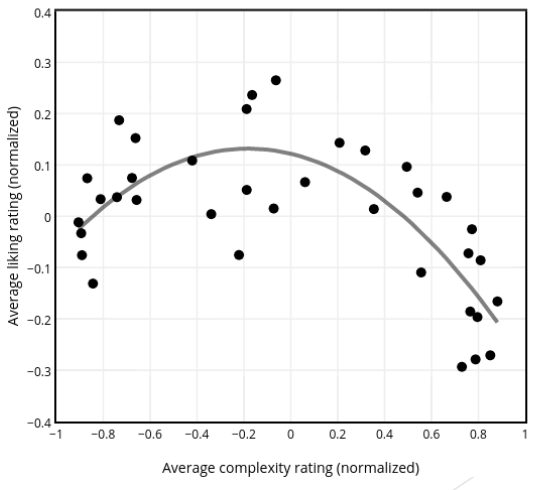
Other factors that shape preference
Aspects of the music*: Pitch (preferring low sounds (like bass in rock music) or high sounds), Timbre, Rhythmic patterns
Previous musical experiences and positive or negative associations
Our openness to new experiences*** (balanced by associations
with and comfort of childhood experiences)
“For many, our future likes and dislikes will be a consequence
of the the types of cognitive schemas we formed for music
through childhood listening.”
The role of music in adolescent development: much more than the same old song
Bridge between psychology of music and developmental psychology in adolescence
Bio-psycho-social effects of music
Music influences key aspects of adolescent development
Music as a protective factor
Music as a risk factor in development
Music in its role for prevention and intervention
Why do developmental psychologist underestimate the
importance of music In adolescence?
Lack of scientific communication
Trends of publications on music and developmental journals
Biological effects of music
Evolutionarily perspective-addresses how music could be an
evolved psychological mechanism, increasing fitness for survival
Music is mediated by and impacts biological structures and
processes (neurotransmitters, hormones etc
Psychological effects of music
Music is an emotional experience”, and serves an adaptive
purpose of emotion regulation
Experience sampling methods
Helping to advance our knowledge about how music induces
emotions
Social effects of music
“music has many different functions in human life, nearly all of
which are essentially social”
A developmental psychology of music in adolescent
investigates the influence that musical behaviors, emotions, cognition, and motives can have on normative and positive development as well as psychopathology
“Music is their soundtrack during intense development period”
On average adolescents listen for up to 3 hours daily >10,000 hours of active music listening through adolescenc
Musical influences of adolescent development
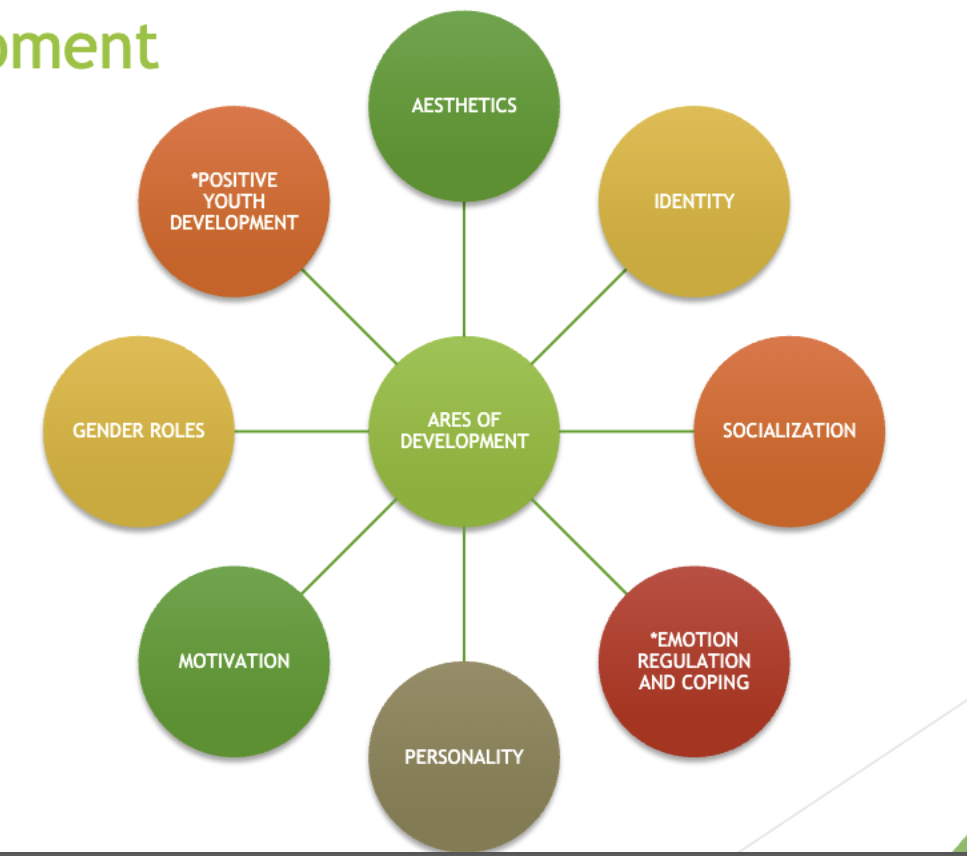
Positive Youth Development
“positive psychology” movement aims to research positive aspects of growth
Findings thus far suggests adolescent emotional wellbeing
is enhanced in the following situations:
Able to experience strong positive emotions from music
Able to develop music tastes with friends and family
Music lessons may boost intellectual abilities and academic achievement
Emotion Regulation & Coping
Essential task to allow adolescent to adapt to many developmental changes
Music fulfills emotional needs
Primary motive for listening to music
Listen to relieve tension and distract themselves
Help with adjustment (self-reflection)& maladjustment (rumination)
Music as risk factor for development of externalizing behavior problems
Controversial music taste is not a cause of mental health issues but marker of emotional vulnerability?
Study demonstrated that genres which explore controversial themes can predict more externalizing behaviors
Repeated exposure to aggressive songs reinforces and primes aggressive behavior in vulnerable adolescents
Music as risk factor for development of internalizing problem behaviors
Music may influence (reduce or increase) subclinical symptoms
Mixed evidence- links btwn preferences and internalizing symptoms vs no risk factor at all
7-year longitudinal study found excessive exposure to media was a RF for depressive symptoms*
Popular music as protective factor
Music as risk factor for risky behaviors (study)
Research in 2012 “fantasizing while listening to music may act as a protective factor against the influence of peer substance use on individual substance use in adolescence”
Two year follow-up study adolescents listening to degrading sexual lyrics predict early sexual activities and intercourse
2008 study showed potential link between music preferences and self harm
Music in prevention & intervention
prevention:
Use of music to distribute information for HIV prevention to peers; Positive outcomes related to HIV prevention behaviors
Educational strategies promoting critical thinking about media products
show promising outcome for media literacy
intervention:
Music therapy can result in decreased depressive symptoms
Intervene on identity formation, resilience, connectedness, competence
CLINICAL IMPLICATIONS: Make a Joyful Noise Integrating Music into Child Psychiatry Evaluation and Treatment
“Music is a remedy, a tonic, orange juice for the ear. But for many of my neurological patients, music is even more—it can provide access, even when no medication can, to movement, to speech, to life. For them, music is not a luxury, but a necessity.”
What is the most common non-school activity of adolescents?
Music, of course!
Occupies approximately 4 hours per day
Important for social connections and for identity
Triggers specific brain pathways associated with pleasure, reward, arousal, and decreases activity in harm/avoidance/risk appraisal pathways.
Specifically, elevates dopamine (=REWARD!), opioid and
oxytocin activity (see next slide)
Playing music has even more benefits than listening
brain structures involved in music
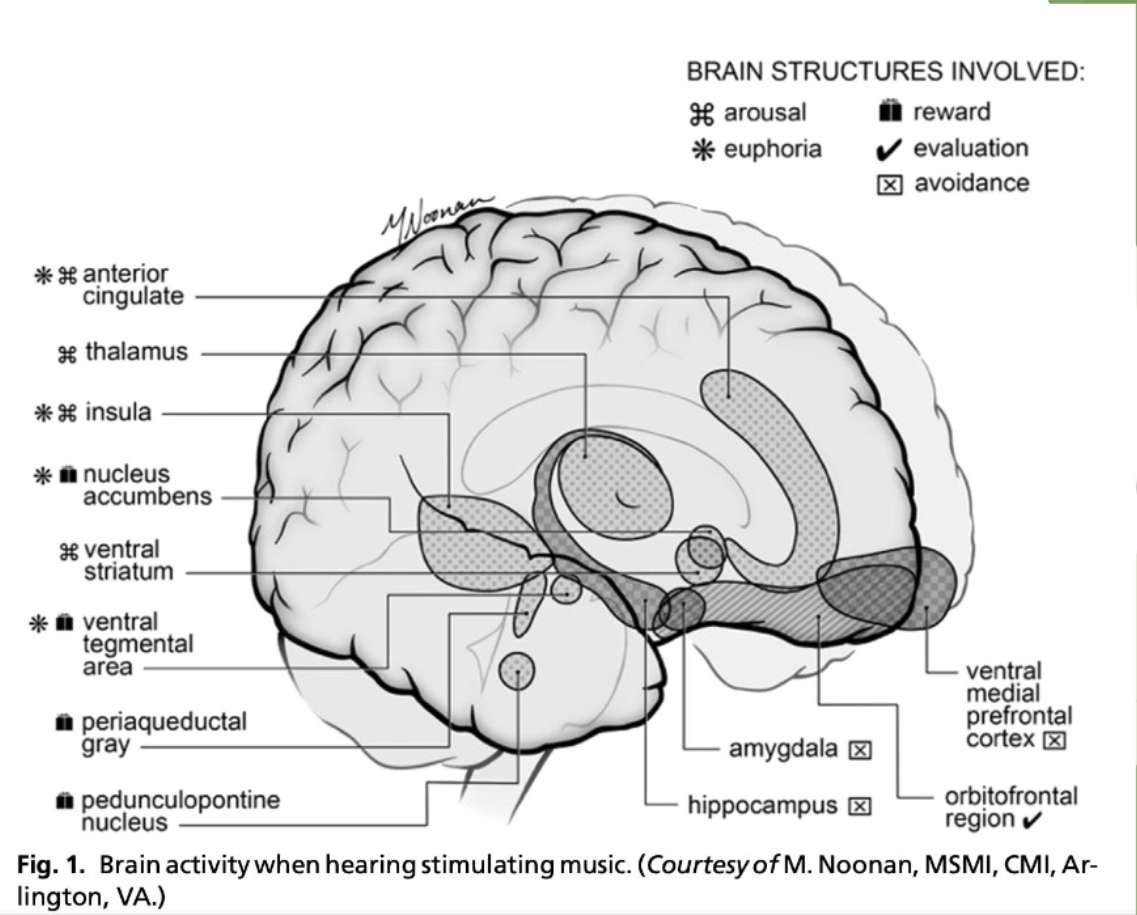
what can child and adolescent psychiatrists do to integrate music into clinical evaluation and treatment?
1) Evaluate roles that music play in a patient’s life- Identify preferences. Any lyrics that are particularly meaningful? Do they participate in music or play any instruments?
2) Evaluate a piece of music itself, and how a patient responds
-Help patients figure out how they can use music to positively alter or regulate their mood
-An alternate approach: goal not to change mood but rather identify with negative emotions (eg sadness), and in doing so to feel better (eg listening to sad music can make you feel calm, relaxed, or comforted*)
-Music as medium to enhance well-being
“In school/work environments, music that is soft, slow, instrumental, and low intensity can be helpful during student _________________ activities.
practice/homework
What makes for effective music practice?
Use all body parts (as relevant)
Play difficult sections slowly at first, emphasis on playing correctly
with attention to how they sound musically
Only after master smaller pieces, connect different parts so that
the piece flows togethe
factors influencing effective musical practice
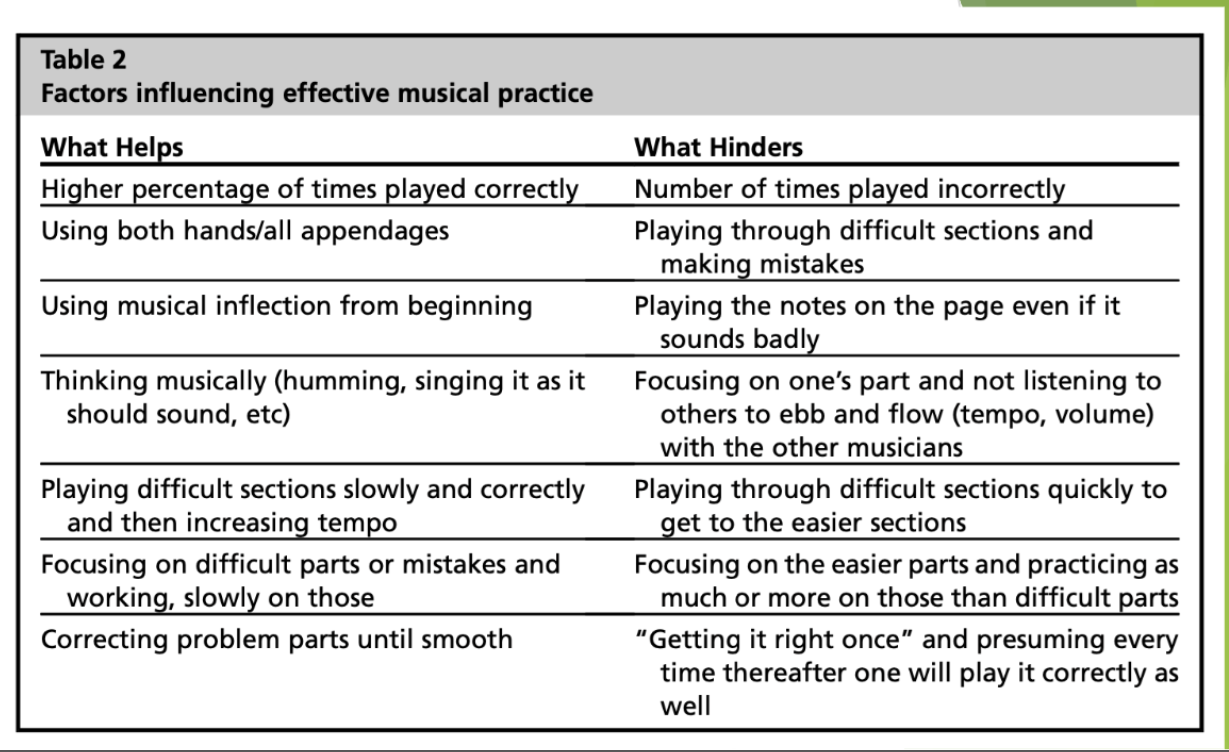
What is the Lullaby Project?
Pairs pregnant moms and new moms /dads with professional musicians to create and sing lullabies together
It was “launched at the Jacobi Medical Center in the Bronx (NYC), by Carnegie Hall’s Musical Connections team, part of the Weill Music Institute, and has been running [...] [since 2011]. In New York City, the project has reached mothers in hospitals, homeless shelters, schools, and correctional facilities. It has now extended significantly across the United States and is beginning to spread internationally.”
the Lullaby Project in the Uk
worked in two areas:
1) Work with migrant mothers and refugees
2) Work with fathers in prison
tried to answer two questions:
What areas of change elicited by the project, if any, as perceived by the participants?
Mechanisms of impact behind its perceived effect?
Lullabies are for mothers as well as for babies (studies)
Cirelli (U of Toronto)-found that when mothers sing ;ullabies to their babies, stress hormone levels dropped in both babies and moms! Despite the fact that many lullabies are “cautionary tales”
In one study: People are asked to listen to songs from other cultures, and identify as healing songs, dance songs, love songs, or a lullaby.—→Identification of lullabies was most consistent!
CLINICAL IMPLICATIONS: Nicholson et al.: Music Therapy to promote Positive Parenting and Child Development (2008)
Sing & Grow: Australian 10-week group intervention, led by music therapists, for parents, mainly based for 0 to 3 (but accepted until age 5)
What parenting behaviors are targeted?*→parent’s expression of affection, physical touch; Praise; Emotional responsiveness to children
Findings of Nicholson study:
High rates of parent satisfaction!*
Improvements on questionnaires, including on child outcomes, parenting behaviors, and parent mental health
musicality
According to the reading (Hallam): “the state of being “musical” which in turn, is defined as being fond of, or skilled in, music.” (p.67)
Often interchanged with “musical ability, musical aptitude, musical potential, and musical talent”
Sensitivity to, knowledge of, or talent for music
The quality or state of being musical: Melodiousnes
one example of environmental exposure is….
maternal smoking and ADHD
The effects of gene-environment interaction on musical ability
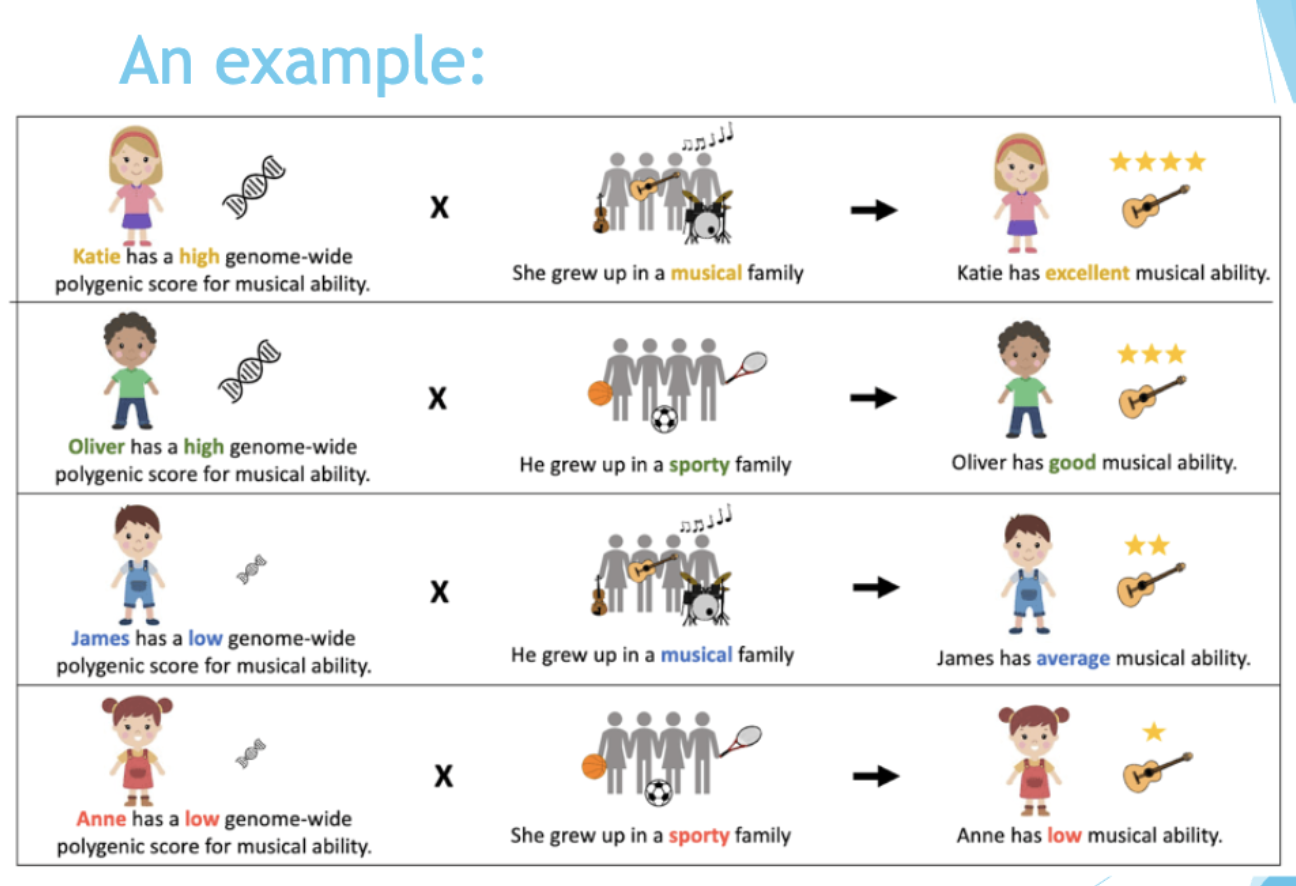
One study found that there is a heritability estimate of __% related to musical abilities
48
why do humans have a propensity towards music?
benefits for mate selection
social and group cohesion
motor-skill development
conflict reduction
trans-generational communication
Perlovsky (2011) has suggested that as spoken language evolved, cognitive dissonances were created between knowledge and instincts. Differentiated emotions were needed for resolving these and music provided a means of developing such a differentiated and refined emotionality.” Hallam, p. 67
“ Adopting a more holistic approach, Cross (2003) suggests that music a has a “transposable aboutness” (p.51), i.e., it has many meanings which can change from situation to situation.” Hallam, p.67
musical savant
People born with below normal levels of general cognitive
functioning (often with autism), but with exceptional
musical talent
Often also visually impaired or with language disorders–
seems to coopt brain areas for musical development
instead
Many with perfect pitch
Environmental aspects as well as genetic–may be drawn
to highly structured codes, leading to repetition and high
levels of internal reward that fuels further practice
Need opportunities for musical engagement to be able to
develop these skill
musical prodigy
Given environmental opportunities, will show exceptional talent from an
early age.
Key factors:
Support of parents and teachers
Extensive practice
Motivation: “the rage to master”→repetitive practicing that fuels mastery
williams syndrome and music
Rare genetic neurodevelopmental disorder, deletion on chromosome 7
Characteristic facial features (elfin)
Low IQ + learning difficulties
Short stature
High rates of musical interest (and with practice, abilities)
Absolute pitch (“perfect pitch”)
Rare ability to identify or produce a given musical note (pitch) without aid of a reference pitch
Significantly more common in professional musicians than in general population (<1/10,000), but even then only 4 to 8?
Can generally say early musical exposure (eg beginning an instrument between ages 3 and 7) is NECESSARY but not sufficient for development of perfect pitch
Tone deafness (congenital amusia)
The inability to recognize musical tones or to accurately
reproduce them*
Emerges early in life and persists throughout adulthood
Affects around 1.5 to 4% of population
Strong hereditary component, but not fully understood
Gordon’s 6 stages of audiation
Stage 1 Momentary retention
Stage 2 Imitating and audiating tonal patterns and rhythm patterns and recognizing and identifying a tonal center and macrobeats
Stage 3 Establishing objective or subjective tonality and meter
Stage 4 Retaining in audiation tonal patterns and rhythm patterns
that have been organized
Stage 5 Recalling tonal patterns and rhythm patterns organized
and audited in other pieces of music
Stage 6 Anticipating and predicting tonal patterns and rhythm
processes
After approximately 2.5 years of musical instrument training, part of
___________ was significantly bigger in the high practicing group
corpus callosum
Expertise paradigm
“If resources are limited and selection has to be made, interest
in music and motivation to engage with it may prove to be the
best predictors of success. If motivational criteria are used for
selection, the musical skills developed are likely to be well
utilized in the long term in some aspect of musical activity”
types of music exposure
1) Listening
Passive: Everywhere in western societies: often
playing in background, in restaurants, gyms,
stores.... Can’t get away from it
Chosen: music videos, downloading music,
streaming, going to concerts, sharing with
friends etc.
2) Performing
Relatively rare in Western societies
More ubiquitous in other cultures where singing,
dancing, drumming etc. may be near universa
effects after listening to music
effects due in fact to changes in 2 aspects of
affective states:
1) arousal levels-that is, how alert do you feel?
2) mood-improved?
listening to music can improve spatial abilities and help performing tasks sometimes afterwards
performance while listening to music
What shapes how background music affects a
primary task?→ How does music make the listener feel? How does music affect processing capacity? Consider bottleneck effect.***
Studies with adults have shown that music with lyrics
is more disruptive, cf instrumental music which is more neutral
Music strongly liked or disliked was also more disruptive.
Personality also plays a role! Who does better with background music, extraverts or introverts?—> extraverts! Seem to like the extra stimulation
Studies have been mixed, esp in children-but generally seem to show small negative effect on reading comprehension and memory.
Calm music, however, benefits active children, presumably by decreasing (heightened) arousal levels and thereby improving concentration
What is known about associations between music training and nonmusical abilities?
its difficult to draw conclusive causal inferences
Pre-existing differences could impact likelihood of taking lessons as well
as testing of abilitie (ex: music aptitude, cognitive abilities, personality, demographic factors)
music aptitude
Designed to be a measure of student’s potential to learn music
Tested by measuring how listeners can perceive and remember sequences of tones that vary in pitch or duration
In tasks that test __________, musically trained individuals tend to do better
perception of speech
5–year-olds who took music lessons for 16 weeks did better on task of phonological awareness than kids in control groups who took no lessons OR swim lessons
Study of 8-year-olds were assigned music OR painting lessons
–those who took music lessons did better on tasks identifying repeated 3 syllable nonsense words.
musicians tend to do better on other language abilities such as:
remembering lists of words that are read or heard
making grammaticality judgements
pronouncing irregularly spelled words (eg “subtle”)
vocabulary
reading comprehension*
Spelling
music does NOT increase ___________ abilities
mathematical
Musical benefits—IQ and academic achievement
Studies have shown that:
Children who take music lessons have higher IQs- even increasing as duration of training increases. Correlation remains even when controlling for SES, and involvement in nonmusical out-of-school activities
Musically trained children get better grades in school than one would expect based on their IQs
available evidence indicates that high-functioning
individuals are likely to take music lessons, and music lessons may exaggerate slightly their pre-existing advantages
music benefits: memory and executive functioning
there is some evidence that music improves executive functioning and memory (includes visual and spatial memory)
musical benefits: social-emotional skills and personality
for adults, duration of music training in childhood correlates with higher scores on “Openness-to-experience” on big 5
music is correlated w openess and conscientiousness
Music training with individual lessons has _____ shown benefits for self-esteem or other social factors (but this might be different in
group settings)
NOT
What conditions in home environment are potential influences on musical learning?
Parental music background
Socioeconomic background
Parent support for practice and lessons
Parental goals and values
Family interaction patterns
Characteristics of parental support:
1) Behavioral Support
2) Cognitive /intellectual support
3) Personal support
Children benefit when parenting style (“emotional
climate”) and practices (“behaviors”) support “the
developing musician’s sense of competence, autonomy,
relatedness, and purpose
suggestions for when a child says “but I don’t want to practice!”
Leave the room
Discuss at another time
Lower expectations for daily practice
Use praise as a reward
“Allow child to choose when and how much
to practice, within parameters negotiated
with the teacher
the ways that music matters

Researchers and music educators should stress importance of
QUALITY!
Responsiveness-be able to improvise and adapt, let children play a role
Live music–”it’s about variation, improvisation, and human interaction”
Multimodal presentation–dance and instruments helps to engage the whole child
What can those wanting to advocate for music do?
Designing maternal and child health care that helps
nurses, doctors, and other health care workers understand
music as a strategy for developing relationships,
emotional health, and communication skills. Imagine
lullaby writing as part of birth classes or well
baby visits.”
Supporting universal pre-school with a strong music
component
Supporting music education
Asking libraries to feature music programming
What helps foster lifelong engagement in music?
Supportive parents
Music playing in the home
Inspiring teachers and educational
programs featuring music
“Resources, attitudes, and
opportunities”
What should be avoided?→Messages that a child is “not good” at music